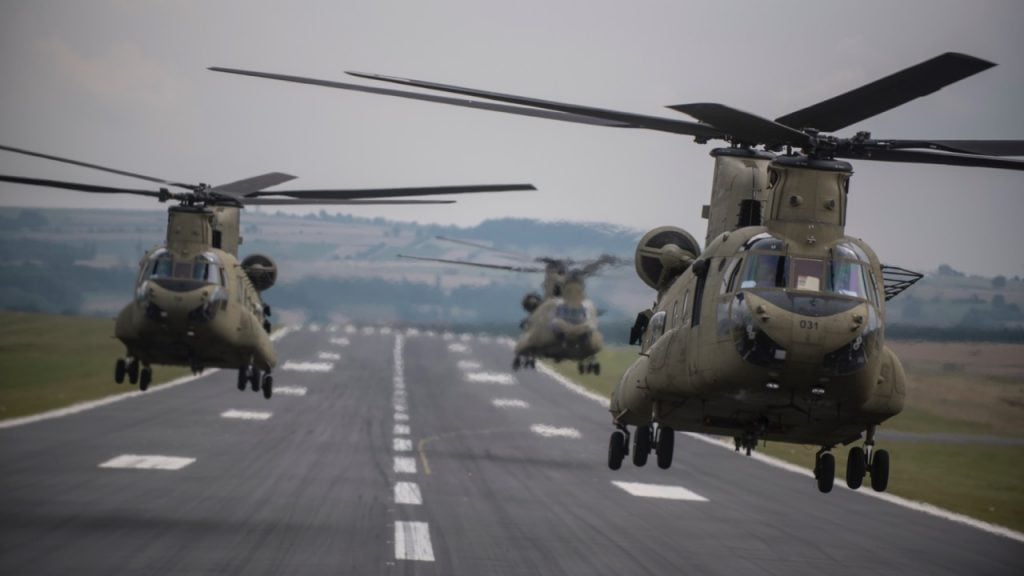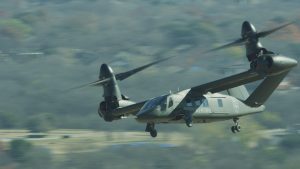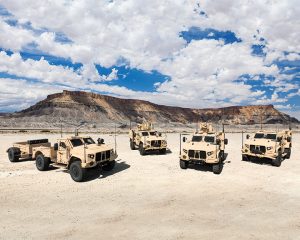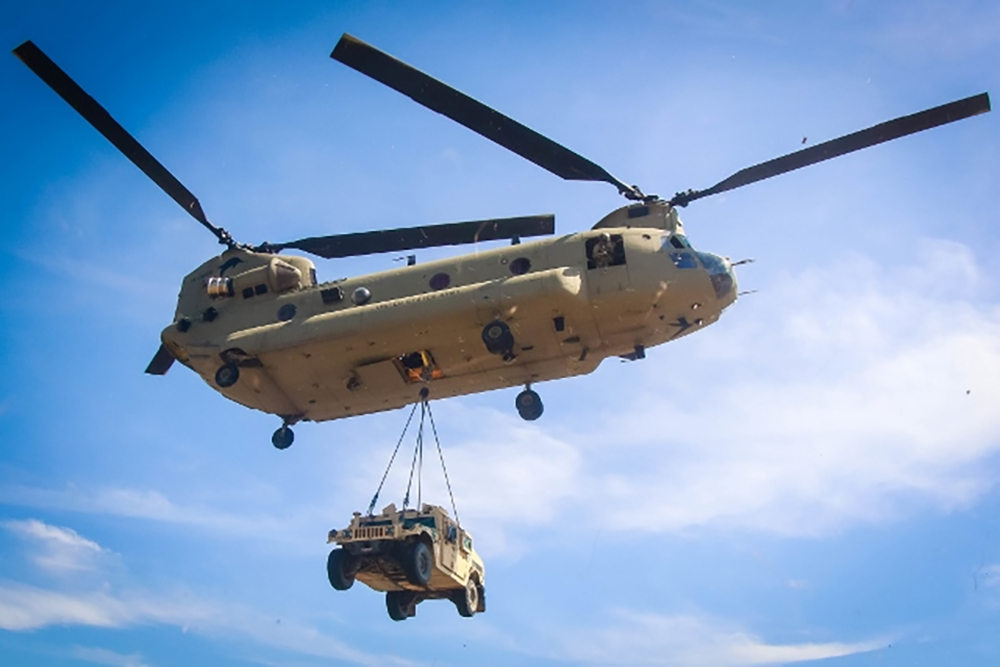Beyond Chinook: Army Secretary Challenges Industry To Revolutionize Heavy Lift
Posted on
WASHINGTON: “I’m asking industry is to think about heavy future vertical lift,” Army Secretary Mark Esper told reporters today. “Where I need their heads to be is thinking about future heavy vertical lift, not about how do we maintain what we have now and make upgrades here or there.”
Translation: Boeing and Pennsylvania legislators, stop fighting me to restore funding for the latest upgrade to the venerable CH-47 Chinook — built outside Philadelphia — and join me in brainstorming a radically better aircraft for future great-power wars with Russia or China.
“I really want to think aggressively, boldly about what the future may hold, how it can be different,” Esper said.
Is that just your advice to industry, I asked, or is there some kind of preliminary study planned that companies could actually get government money for?
It’s premature to talk dollars, Esper replied. “Whether we help fund that at some point, I don’t know, I’m not going to talk about that right now,” he said. “My comment was only we need aircraft in the future that can do that heavy vertical lift movement, but can … survive in a very contested airspace and keep up with the FARAs and FLRAAs.”
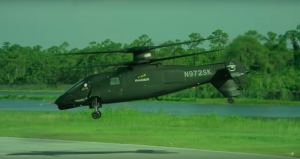
Sikorsky’s S-97 Raider, a leading candidate for the Future Attack Reconnaissance Aircraft, shows off its agility.
That’s the Future Attack Reconnaissance Aircraft — a light scout to fill the gap left by the retired OH-58 Kiowa — and the Future Long-Range Assault Aircraft — a mid-size transport to replace the UH-60 Black Hawk. Both are intended to be high-speed, long-range aircraft.The solution probably will be turboprop/helicopter hybrids, rather than conventional helicopters, that can operate on fast-paced, far-flung future battlefields where precision-guided missiles can kill the forward fuel depots and maintenance bases on which today’s shorter-ranged helicopters rely. FARA is the Army’s top-priority aircraft program, Esper reiterated here at the Brookings Institution today, and FLRAA is No. 2.
But once the light scout and the mid-size transport programs are further along, Esper said for the first time today, his no. 3 priority will be a new heavy hauler. “We’re not there yet, right, obviously we need to get FARA and FLRAA moving,” Esper said.
“No. 3 is I need to eventually think about what’s the future of heavy vertical lift,” Esper told the audience at Brookings. “What’s the future replacement for the Chinook” with the greater speed, range, payload, and survivability required for future battlefields?
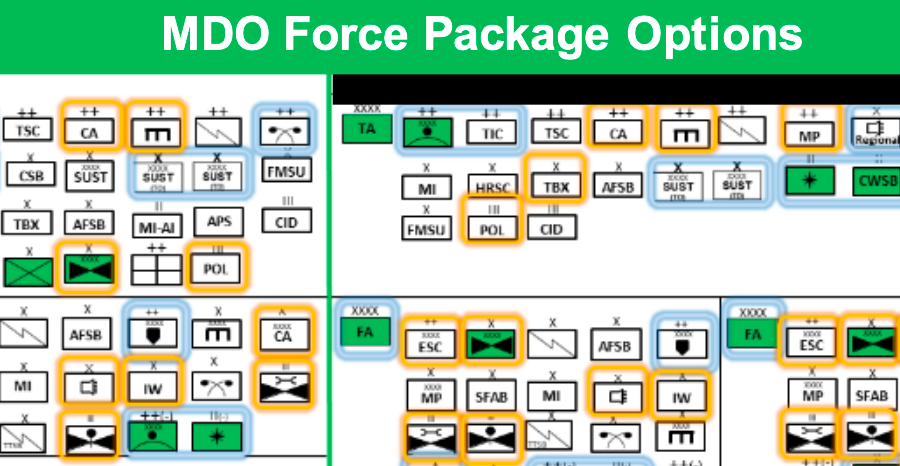
Part of the Army’s early draft for new Multi-Domain formations. Green: existing units to receive new equipment. Blue: new units to be created. Orange: units currently in the National Guard or Reserve that might move to the regular active-duty force.
Big Decisions Ahead On Big Wars
Why isn’t the biggest aircraft the biggest priority? The Black Hawk carries at most 10 soldiers — less in most mission profiles — and the FLRAA replacement will carry 12. The CH-47, however, can carry dozens of fully equipped infantry inside, 10 tons of supplies, or, in a sling suspended beneath the aircraft, a howitzer or a Humvee. The CH-47F Block II upgrade would increase that payload to accommodate the new and much better-armored Joint Light Tactical Vehicle (JLTV). But the Army’s 2020 budget plan cancels the CH-47F Block II and slows down JLTV to focus on the Big Six capabilities deemed most essential future high-intensity warfare: long-range artillery, armored vehicles, high-speed Future Vertical Lift aircraft, secure networks, air & missile defense, and soldier gear — in that order of priority.
“I think JLTV is a very capable vehicle, we need it, we will use it for sure, we still have an IED threat out there,” Esper told reporters. “How many do you need? My response is, I really can’t tell you today what the final number will be, [because] I don’t know, as we reorganize the Army, how that would shake out.”
“I don’t think we can say that on anything right now, not just JLTVs,” Esper continued. “I can’t tell you how many Next Generation Squad Weapons I’ll buy [or] how many FARAs and FLRAAs.”
“My crystal ball doesn’t look out 20-30 years,” he said. “Even [the next] five years will be shaped by whatever our wargaming tells us.”
That’s because the recently created Army Futures Command is still doing a top-to-bottom review of how the force should be reorganized to wage future Multi-Domain Operations against high-end threats like Russia and China. The Army is testing new technologies, tactics, and units in tabletop wargames, computer simulations, and field experiments.
The most notable is the Multi-Domain Task Force in the Pacific, which combines existing Army missile launchers with a brand-new intelligence/cyber/targeting battalion. The goal: To test how ground troops can support operations against China, with island-based anti-ship, anti-aircraft, and missile defense units serving as an unsinkable anvil for Navy and Air Force hammers. Moving heavy artillery across the vast Pacific would be a challenge even for the Marines‘ current V-22 Osprey tiltrotor, let alone the Army’s relatively short-ranged helicopters.
But the Pacific task force is just one example of the future combat organizations the Army is now studying, all of which would change requirements for manning, transport, maintenance, and supply. Just one project, semi-autonomous supply trucks that follow a manned lead vehicle, could free up thousands of transport corps drivers for other missions, Esper noted.
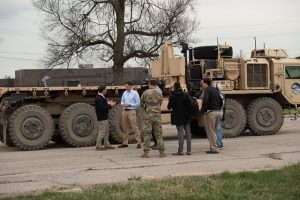
Army Secretary Mark Esper (left) getting briefed on the self-driving “leader-follower” autonomous vehicle (in background).
“The Army I grew up in we had a much more robust nuclear/biological/chemical [defense], we had more robust artillery, and we had more robust electronic warfare,” Esper told reporters. “I do see those things going back into our formations.”
“Then there’s the new stuff like cyber,” he continued. “Right now we’re planning to put cyber teams at the brigade, division, and corps level, [but] as we run these wargames, they may say, well, battalions may need cyber” — which would mean training and equipping many more cyber/electronic warfare specialists.
“These next 12 to 18 months are going to really inform where we go in terms of the formation, the equipping, and the manning,” from how small units are organized to the total end strength needed for the regular Army, National Guard, and Army Reserve, Esper said. “We need to let the wargames, the gaming, play out and see how it changes our formations…. If we need more of this and more of that, it changes our procurement.”
This is the larger, more complicated, and constantly changing context in which Esper and other Army leaders evaluated programs like Chinook.
The Old, The New, & The Revolutionary
The unique paradox of the CH-47 is that the design is one of the Army’s oldest — the first Chinooks entered service in 1962 — but the individual aircraft are some of the Army’s youngest — with the fleet upgraded and rebuilt to the CH-47F Block I standard. By contrast, the Army has no thoroughbred scout aircraft in service since it retired Kiowa, and the stopgap replacement of much heavier AH-64 Apache gunships working with drones has proved unsatisfactory.
“The CH-47 is a very good aircraft, I have a ton of hours in the back of the CH-47, and we will continue to buy CH-47s [specifically, the MH-47G variant] for the Special Operations force,” Esper told the audience at Brookings, “but we are halting procurement for the conventional Army. It’s not a statement on the aircraft or the company’s performance. What it is, is a statement [of] priorities.”
The Army simply needs the new light scout and mid-size transport more, Esper said. But a future heavy lift aircraft will come third, so people should start brainstorming today.
“I want the rotorcraft industry…to start thinking about what is the future of heavy vertical lift,” Esper said. “It may be a version of CH-47. I don’t know.”
“I need an aircraft that can survive… that has greater range, greater speed, greater payload,” he said, “because I can’t have FARA and FLRAA zipping down the battlefield and meanwhile our other aircraft can’t keep up.”
Subscribe to our newsletter
Promotions, new products and sales. Directly to your inbox.

